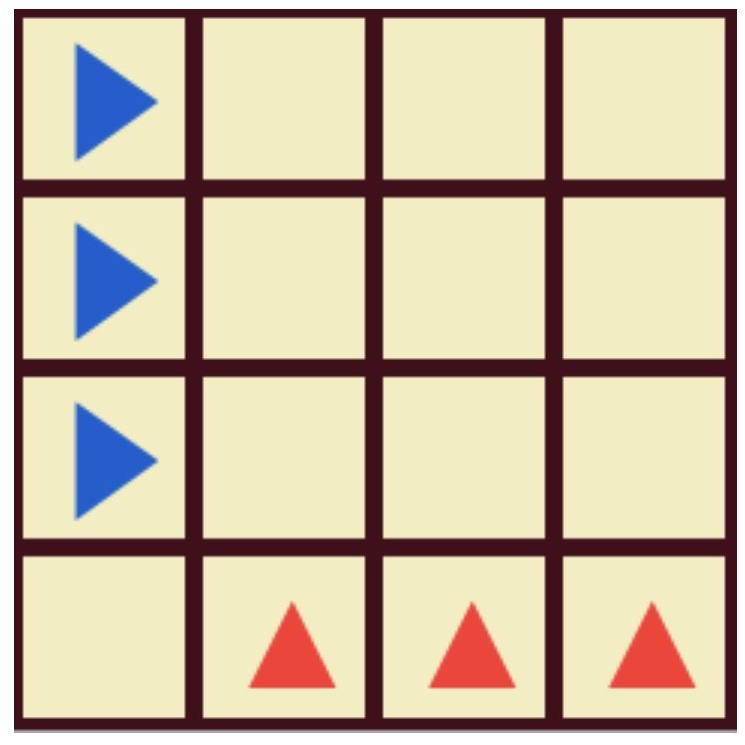How to play dodgem
Aug 22, 2025 by Katsutoshi Seki
Tags:
game
javascript
english
This article explains how to play Dodgem.
Rules
On an n×n board, n−1 blue pieces are placed in the leftmost column and n−1 red pieces in the bottom row. The figure below shows the case n=4.

- Blue moves first, then Red, alternating turns.
- Blue pieces move to the right as their forward direction; they may also move vertically (up or down) by one square.
- Red pieces move upward as their forward direction; they may also move horizontally (left or right) by one square.
- Pieces may move only to empty squares. No jumps, captures, or stacking.
- When a piece reaches its exit edge (Blue: rightmost column; Red: top row), it can be removed on a subsequent move.
- Players must not block their opponent’s movement completely. Equivalently, if you have no legal move on your turn, you win.
- The player who removes all of their own pieces first wins.
- If the same position appears three times, the game is a draw.
Controls
- Click or tap the piece you want to move, then select the destination.
- Double-click or double-tap the same piece to remove it, if removal is available.
- Select the board size, whether you play first or second, and the computer’s strength (levels 1–3), then press the “Start Game” button to begin a new game.
- Selecting “Watch” lets the computer play itself. You can choose the playback speed; selecting “100” runs 100 games continuously. You can change the speed or stop at any time.
- When playing consecutive games with the same settings, wins and losses are recorded. The record resets if you reload the page or interrupt the run.
Strategy by board size
It is known that 3×3 is a first-player win, while 4×4 and 5×5 are draws with perfect play.
- First, aim to consistently beat the computer as the first player on 3×3.
- On 4×4 and 5×5, you cannot force a win against perfect play, but you have good chances at Levels 1 and 2. Because winning as the first player is easier, aim to win as the first player and draw as the second.
- On 4×4 at Level 3, defeating the computer is very hard, so focus on securing a draw. If the computer detects a forced win, it will display a notification. Study these positions before returning to Levels 1 and 2 to improve your chances.
- On 5×5 at Level 3, the computer is strong but still far from perfect play, so you have a good chance to win; aim to win when playing first.
- For human-vs-human play on 4×4 or larger boards, a fair format—similar to chess championships—is to alternate colors an equal number of times and compare results.
About this program
- This program is written in JavaScript. Source code. It requires loading pako.
- It loads, as a compressed evalmap, a subset of the position‑evaluation database computed offline in MongoDB by a nearly perfect analysis Python program. Because the online version does not use MongoDB, it supports CPU levels 1–3 only; the MongoDB‑backed level 4 is available in the local CLI/GUI version. The strength of each level was verified with the Python program.
Reference
- Berlekamp, Elwyn R.; Conway, John Horton; Guy, Richard K. (2003), “Dodgem,” Winning Ways for your Mathematical Plays, vol. 3 (2nd ed.), A.K. Peters, pp. 749–750, ISBN 978-1-56881-143-7.
- Discussion thread, rec.games.abstract (1996). David desJardins created win–loss tables for 4×4 and 5×5, concluding they are draws.
- Wikipedia article